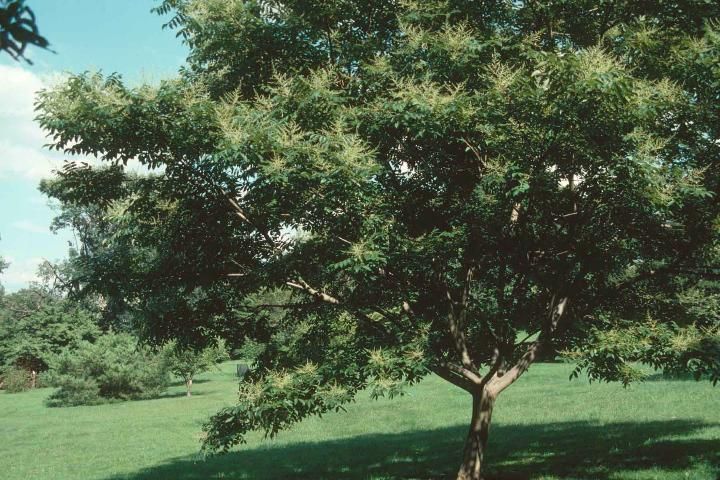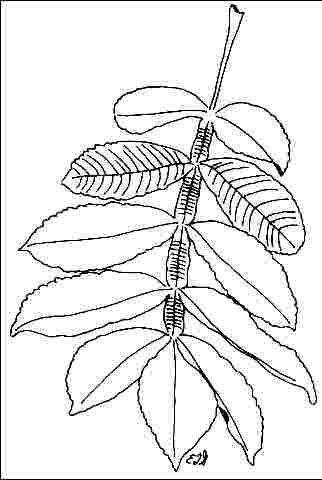Introduction
Chinese sumac forms a loose, spreading small tree, reaching up to 25 feet in height. Most specimens only grow to about 12 to 15 feet tall. The shiny, pinnately compound, five inches long leaves change to a brilliant orange, red, or yellow in the fall before dropping. The yellowish-white, summertime flowers appear in 6- to 10-inch-long and wide, terminal panicles and are quite showy. The hairy fruits which follow are orange/red and mature in October.

Credit: Ed Gilman, UF/IFAS
General Information
Scientific name: Rhus chinensis
Pronunciation: roose chih-NEN-sis
Common name(s): Chinese sumac
Family: Anacardiaceae
USDA hardiness zones: 5B through 8A (Fig. 2)
Origin: not native to North America
Invasive potential: invasive non-native
Uses: reclamation; container or planter; specimen; deck or patio; highway median
Availability: somewhat available, may have to go out of the region to find the tree

Description
Height: 15 to 20 feet
Spread: 15 to 20 feet
Crown uniformity: irregular
Crown shape: round
Crown density: moderate
Growth rate: moderate
Texture: medium
Foliage
Leaf arrangement: alternate (Fig. 3)
Leaf type: odd-pinnately compound
Leaf margin: crenate, serrate
Leaf shape: ovate, oblong, elliptic (oval), obovate
Leaf venation: pinnate
Leaf type and persistence: deciduous
Leaf blade length: 2 to 4 inches
Leaf color: green
Fall color: orange, red
Fall characteristic: showy

Flower
Flower color: white/cream/gray
Flower characteristics: showy
Fruit
Fruit shape: round
Fruit length: less than .5 inch
Fruit covering: fleshy
Fruit color: red, orange
Fruit characteristics: does not attract wildlife; showy; fruit/leaves not a litter problem
Trunk and Branches
Trunk/bark/branches: branches droop; not showy; typically multi-trunked; thorns
Pruning requirement: needed for strong structure
Breakage: susceptible to breakage
Current year twig color: brown, reddish
Current year twig thickness: thick, very thick
Wood specific gravity: unknown
Culture
Light requirement: full sun
Soil tolerances: clay; sand; loam; alkaline; acidic; occasionally wet; well-drained
Drought tolerance: high
Aerosol salt tolerance: unknown
Other
Roots: not a problem
Winter interest: no
Outstanding tree: yes
Ozone sensitivity: unknown
Verticillium wilt susceptibility: susceptible
Pest resistance: free of serious pests and diseases
Use and Management
Training is required to make this large shrub into a tree. Begin by staking the main stem in the upright position for a year or two and develop branches beginning at two to four feet from the ground. Space branches 8 to 12 inches apart and be sure than they form a wide angle with the trunk. This will help ensure that they are well attached to the tree. Occasional pinching or heading back of the terminal shoot will increase branching.
Place Chinese sumac in a prominent location in the landscape in the full sun. It is a nice tree for planting in a low ground cover to display the interesting trunk and branch arrangement. The fine-textured foliage, showy flower display and bright fall color combine to make this small tree suitable for increased usage in southern landscapes.
Chinese sumac should be grown in full sun on well-drained soil, acid or alkaline. It would be well suited for inclusion in a low maintenance landscape where plants receive little if any irrigation. Suckers from the base of the trunk may have to be removed periodically.
Propagation is by seed.
The cultivar 'September Beauty' has a nice shape and provides reliable yellow-orange fall color.
Pests
Aphids suck plant juices, but they can be easily controlled. Aphids may also be dislodged with a high pressure water spray from the garden hose.
Scales can be partially controlled with dormant oil applied in the spring before plants begin to grow.
Diseases
Several fungi cause cankers leading to dieback. Fertilize to keep plants healthy and prune out infected parts.
Fusarium wilt infects roots, causing the leaves to droop and wilt. A light infection causes only gradual dwarfing or yellowing and premature red leaf coloration.
Leaf spot causes gray spots with purplish margins that merge, giving the leaves a scorched appearance.
Various genera of powdery mildew forms a white coating on the leaves.
Verticillium wilt causes wilting of individual stems, followed by death of the foliage. Eventually the entire plant dies. Prune out infected branches. Do not replant in the same spot with sumac or other susceptible plants.